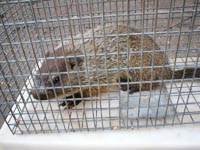|
|
WOODCHUCK
REMOVAL
Woodchuck biology
Minnesota’s
woodchucks are a member of the squirrel
family and are vegetarians. They have many names including Marmots,
Ground hogs, whistle pigs. They weight between 5.5 to 12 lbs and are
20-25” long. They have 1 litter a year in April or early May
with 4-5
young. The young are born blind and fur less. They open their eyes and
start crawling out at 1 month old.
Symptoms
Seeing large piles of earth around a 8 to 12” hole. Large
amount of
dirt under decks or near the foundations. Woodchucks will dig between
2-5 entrances to it burrow and the
dirt will be piled at the main
entrance. Damage to vegetable crops such as beans, squash and peas can
be costly and extensive. Fruit trees and ornamental shrubs also may be
damaged by woodchucks. If you are loosing large amounts of plants, it
could be whistle pigs doing the damage. If threatened woodchucks can
climb trees and swim!!!!
 Removal Removal
The removal all starts with a inspection. We will come out and
access the damage and identify the specie doing the damage. Then we
will
set the appropriate traps to remove the animals. We will also recommend
habitat modifications and exclusion available for your site.
Exclusions
A more permanent solution to a Woodchuck problem is to use a exclusion
technique to permanently keep the woodchuck from burrowing under your
deck, shed or other structure. For this we use hardware cloth buried
into the ground and attached to the structure, this prevents the
woodchuck from burrowing
Health
Concerns
Woodchucks are known carriers of Colorado tick fever, Rabies, Lyme
disease, Rocky Mountain spotted fever, Leptospirosis, Murine Typhus,
Plague and Tularemia. Even though most of these diseases are rare in
Minnesota, they have showed up in other woodchucks around the country.
|

